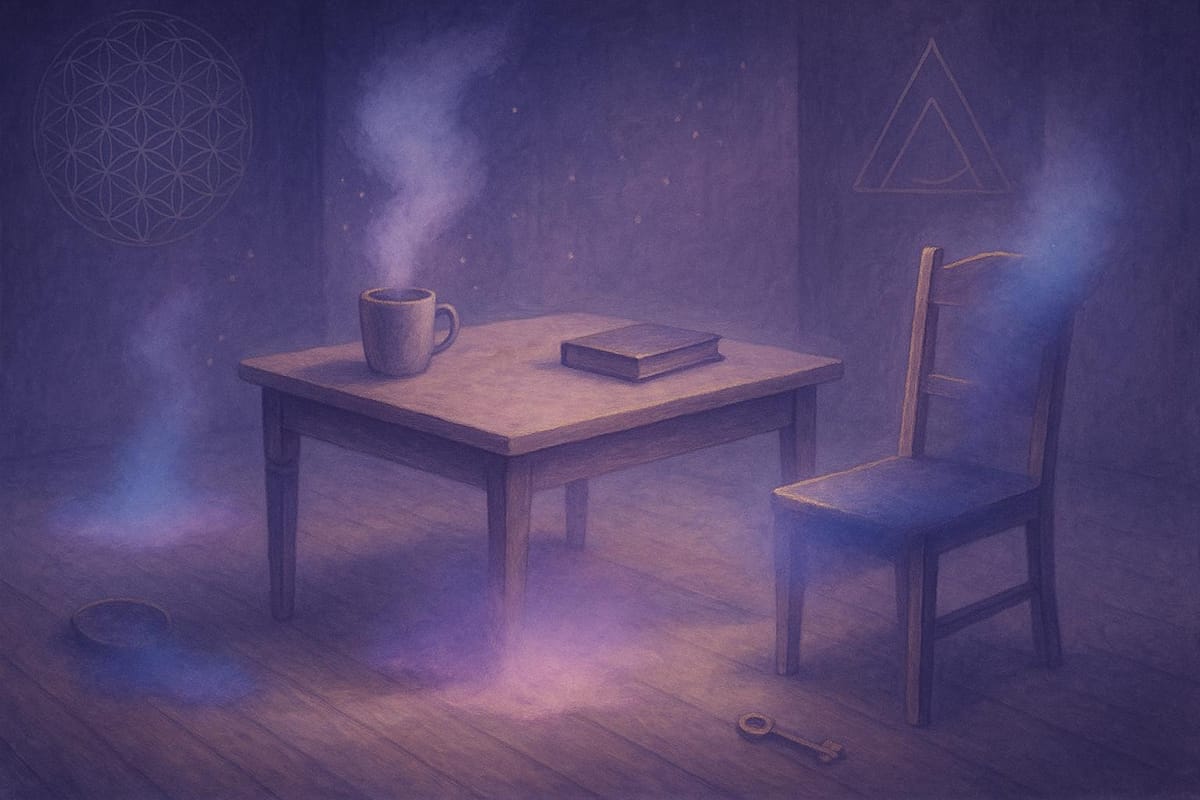Signs of a Simulation Glitch: Missing Objects
Explore the mysterious phenomenon of missing objects and their connection to simulation theory and potential glitches in our reality.

Have you ever had an object disappear without explanation, only to reappear later in a strange place?
These puzzling events, like losing keys or jewellery, could be more than forgetfulness. Some believe they might reveal "glitches" in our reality, hinting we could be living in a simulation.
Here’s what you need to know:
- Simulation Theory Basics: This idea suggests our reality could be a highly advanced computer simulation.
- Common "Glitches": Objects vanish from sealed spaces, reappear in impossible places, or come back after long absences.
- Possible Causes: These events might result from system errors, quantum effects, or even our own memory flaws.
Top 10 Bizarre Glitches In The Matrix You Were Never Supposed To See
Types of Missing Object Events
When objects mysteriously vanish, these events tend to follow three distinct patterns. Each sheds light on potential anomalies that challenge our understanding of reality and hint at possible simulation glitches.
Objects Vanishing from Sealed Spaces
One of the most puzzling scenarios involves items disappearing from locked or secured areas. These events defy logical explanation, particularly after ruling out mundane causes like hidden compartments or accidental misplacement.
"Most of the time, the objects are returned around the same location from which they were borrowed or they are placed in our path in an extraordinary way."
Objects Found in Impossible Places
Sometimes, missing items reappear in locations that are, quite literally, impossible. These occurrences, often referred to as Out-of-Place Artifacts (OOPArts), highlight inconsistencies in how reality seems to function.
For instance, Karen T. Hluchan shared a case where two rings reappeared on a white carpet in a doorway exactly six months after they vanished. The homeowner confirmed she had never placed them there.
Time-Delayed Reappearances
Another common pattern involves objects vanishing for varying lengths of time before unexpectedly showing up again. These cases generally fall into two categories:
- Short-term disappearances: Items reappear within a few days or weeks. For example, an earring resurfaced in a dresser drawer two weeks after it went missing.
- Long-term disappearances: Objects remain absent for months or even years. In one instance, a wedding ring reappeared on a front lawn after being lost for a decade.
Interestingly, personal items like jewelry seem to be particularly prone to these anomalies. Some speculate that this could be tied to the emotional or energetic connection people have with such objects.
The simulation hypothesis offers one possible explanation, suggesting these events might represent temporary data inconsistencies or "glitches" in a simulated environment. These patterns not only intrigue but also invite deeper investigation into the nature of our perceived reality.
Possible Causes
The phenomenon of vanishing objects stirs curiosity across both scientific and philosophical realms. When viewed through the lens of simulation theory, several intriguing explanations emerge.
System Errors in Reality
Imagine reality as a computational system. Just like software can glitch, a similar "processing error" might explain why objects suddenly disappear. In software development, there's a concept often referred to as the "remainder" principle - where certain aspects of a system defy full predictability.
"This lens shows software development as an ongoing struggle between the real and the symbolic, the known and the unknown. Observability tools are a means to confront and explore the unconscious parts of systems, uncovering bugs and issues that elude initial understanding or categorization."
These glitches could create anomalies in our perceived reality. Beyond computational errors, quantum physics may also play a role in these mysterious disappearances.
Quantum Effects and Multiple Dimensions
Quantum mechanics opens up a world of possibilities, particularly through concepts like non-locality and entanglement.
For instance, China's Micius satellite demonstrated how particles could remain correlated over vast distances. This suggests that non-local interactions might influence the physical world in ways we don’t fully understand, potentially causing objects to vanish.
"Local Realism assumes that nature consists of stuff, of objectively real objects, i.e., stuff you can put inside a box... It further assumes that objects exist whether or not we observe them."
Such experiments challenge the idea that objects are independent entities, hinting at a deeper, interconnected reality.
Metaphysical Factors
Stepping outside the realm of physics, metaphysical perspectives offer another layer of explanation. Some theories propose that objects only exist in relation to other entities. This idea aligns with concepts like:
- Conscious Observation: The observer effect in quantum mechanics suggests a profound connection between consciousness and physical reality.
Even Neil deGrasse Tyson has speculated on the complexity of our reality, stating there’s "better than 50-50 odds" that it’s far more intricate than it seems.
Real Glitches vs Normal Events
Distinguishing actual glitches in reality from everyday misplacements requires careful verification. Research shows that 30% to 50% of people report experiencing at least one unusual or anomalous event in their lifetime. This makes it crucial to approach such situations systematically.
Memory Tests and Reality Checks
Human memory isn’t as reliable as we’d like to think, especially when it comes to misplaced objects. According to the source monitoring framework, our memories don’t come with tags that identify their origin. Instead, we infer their source based on certain features.
To verify a potential glitch, consider these steps:
- Document immediately: Write down every detail while the memory is still fresh.
- Check physical markers: Look for evidence that confirms the object’s previous location.
- Cross-reference with others: Ask others if they recall seeing the object in the same spot.
| Reality Check Type | Purpose | Verification Points |
|---|---|---|
| Environmental Scan | Verify physical context | Were there recent changes in the space? |
| Memory Assessment | Test recall accuracy | Can you recall specific details about it? |
| Witness Verification | Confirm shared experience | Did others see it in its last location? |
Concrete physical evidence can also help separate genuine glitches from simple forgetfulness or misplacement.
Physical Evidence Review
Physical evidence plays a key role in verifying a suspected reality glitch. Studies suggest that real events are often accompanied by richer sensory and contextual details compared to imagined ones.
Here are Primary Evidence Markers that might point to a simulation error:
- Photographs showing the object in its original location
- Security camera footage
- Digital timestamps from devices
- Physical impressions or marks left behind
Interestingly, many anomalous experiences occur during or after intense emotional events.
Steps for Critical Assessment:
- Investigate the physical area for signs of movement or disturbance.
- Cross-check digital records, physical evidence, and environmental conditions simultaneously.
- Rule out logical explanations that align with known physical laws.
Since vivid hallucinatory experiences are not uncommon, it’s important to thoroughly document all observations before concluding that a glitch in reality has occurred.
Recording and Tracking Methods
Keeping track of missing objects can uncover patterns hinting at deeper anomalies. These records connect past occurrences with present observations, offering a foundation for exploring the simulation theory.
Event Documentation
A clear and structured method for documenting events ensures that details are captured accurately while they’re still fresh in memory.
Key Event Details:
- Date and time: When the event occurred.
- Location: Specific area or room where the object was last seen.
- Object description: A detailed account of the missing item.
- Last known position: Where the object was placed before disappearing.
- Witnesses: Names of others who were present.
- Personal state: Emotional or physical condition at the time.
Environmental Observations:
- Weather at the time of the event.
- Any active electronic devices nearby.
- Recent changes in the space (e.g., furniture moved).
- Unusual occurrences, like flickering lights.
- Notable shifts in air pressure or temperature.
Incident Follow-Up:
- How long the object was missing.
- Circumstances of its reappearance (if applicable).
- Any physical changes to the object.
- Statements from witnesses about what they observed.
| Documentation Type | Details | Purpose |
|---|---|---|
| Initial Report | Time, date, location, object description | Establish basic facts. |
| Environmental Log | Weather, electronics, atmospheric conditions | Identify external influences. |
| Witness Records | Names, statements, timestamps | Confirm shared experiences. |
| Follow-Up Notes | Changes, developments, resolutions | Track the event's progression. |
Thorough documentation like this not only provides clarity but also creates a foundation for identifying potential system glitches within what some theorize as a simulated reality.
Pattern Recognition
Once the data is collected, analyzing it for patterns can help separate true anomalies from everyday occurrences. Memory distortions, for instance, might explain some cases of missing objects.
Framework for Pattern Analysis:
-
Temporal Patterns:
Look for connections based on time - specific hours, days of the week, or even seasonal trends. -
Spatial Relationships:
Identify common locations where objects disappear or reappear. Note characteristics of these spaces, like layout or lighting. -
Object Characteristics:
Examine the missing items for shared traits, such as material, size, age, or sentimental importance.
"Human memory isn't a perfect recording; it's more like a reconstruction - fragile, flawed, and prone to error." - Mark Derho, Resident Magazine Author
Advanced Tracking Tools:
- Use digital logs to record timestamps and include photos for visual reference.
- Monitor environmental factors like electromagnetic fields or barometric pressure for potential clues.
Moving Forward
When objects mysteriously go missing, they often reveal more than just a misplaced item - they can hint at hidden layers of reality. By systematically documenting these events, we can transform perplexing moments into opportunities for insight.
Approaching such occurrences with balance and curiosity sharpens our ability to investigate them meaningfully. These incidents might go beyond simple explanations, potentially uncovering deeper patterns in our consciousness and the nature of reality itself.
"The state, process, and practice of remembering to observe moment-to-moment experience with openness and without automatic patterns of previously conditioned thoughts, emotions, or behaviors."
Mindfulness can be a powerful tool in distinguishing between genuine anomalies and simple forgetfulness. Here are a few ways to incorporate mindfulness into your approach:
- Pay attention to your thoughts and emotions without judgment when objects seem to disappear.
- Take a closer look at your immediate surroundings.
- Use the "five senses" exercise to ground yourself during moments of uncertainty.
- Keep a record of your observations, noting any recurring patterns or insights.
By combining mindfulness with a keen eye for patterns, you can deepen your understanding of these puzzling phenomena. Pay attention to temporal, spatial, and emotional elements that might connect these events, as they could point to underlying anomalies.
Philosopher Nick Bostrom has suggested that experiences like these could offer glimpses into the possibility that our reality holds more layers than we typically perceive. Investigating these moments with an open mind turns them into tools for exploring the nature of existence.
Adopting a "beginner’s mind" - approaching each situation with fresh curiosity rather than preconceived ideas - can lead to deeper insights and personal growth.
Ready to step beyond information and into activation?
This blog is part of an ongoing personal study — a living exploration of simulation theory, manifestation, and reality-bending. If something here resonated, you’re not here by accident.
Join the journey.
Get deeper insights, tools, and transmissions delivered to your inbox: no noise, no fluff — just real signals for seekers.
FAQs
How can I tell if a missing object is due to a simulation glitch or just forgetfulness?
When something goes missing, figuring out whether it’s a case of forgetfulness or a possible simulation glitch often depends on the patterns and context surrounding the event. A glitch might look like objects vanishing and reappearing in bizarre or illogical places, or a series of strange events happening at once. These situations can feel downright puzzling, almost as if reality itself isn’t playing by the usual rules.
On the other hand, forgetfulness tends to have more ordinary causes - like being distracted, stressed, or trying to juggle too many things at once. Losing track of keys or other everyday items is pretty normal when your mind is elsewhere. If the disappearance seems random and isolated, it’s probably just a moment of absentmindedness. But if you start noticing repeated, strange patterns, it might make you wonder if there’s something bigger at play - maybe even a glitch in the simulation.
How do quantum mechanics and multiple dimensions explain missing objects in a simulated reality?
Quantum mechanics and the idea of multiple dimensions offer some fascinating perspectives on phenomena like "simulation glitches", such as objects vanishing or reappearing. In quantum mechanics, particles can exist in multiple states at once until they’re observed - a concept famously illustrated by the double-slit experiment. This raises the possibility that reality might not be as fixed as we assume, and what we perceive as glitches could stem from how observation interacts with the underlying mechanics of the simulation.
The theory of multiple dimensions takes this a step further. It suggests that our reality could be just one of many overlapping dimensions. When these dimensions interact or momentarily interfere with each other, it might explain strange occurrences, like objects suddenly disappearing or reappearing. Together, these ideas push us to rethink how we perceive reality and consider whether such oddities might hint at a simulated existence.
Are certain objects more likely to disappear in a simulation glitch, and why does this happen?
Some items seem to have a knack for disappearing, almost as if they’ve fallen victim to a simulation glitch. Think about it: keys, phones, jewelry - small objects that we use often or handle regularly. These are the things most commonly reported in these mysterious vanishing acts. Their size and constant movement make them easy to misplace or overlook, which only adds to the puzzling nature of these incidents.
On a more speculative note, some argue these strange occurrences might hint at a flaw in the 'code' of a simulated reality, where certain objects fail to appear or "render" as they should. Whether these moments are actual glitches, odd anomalies, or just lapses in our attention, they serve as curious prompts to question the reality we believe we’re living in.




